Religion
View the photo galleryReligious divides in Dublin in the early twentieth century were rarely marked with violence. Dublin was not Belfast or Derry. Sectarianism among Dubliners was more nuanced, more apparent in its implicit understandings of distinctiveness, but it was a defining presence in city life. In 1911 the city was 83% Catholic, 13% Church of Ireland, 2% Presbyterian and Methodist and 2% others, including a growing Jewish presence.
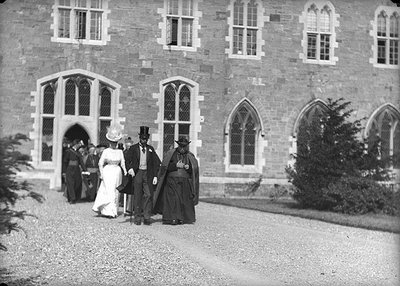
Archbishop of Dublin, William Walsh walks alongside King George V and Queen Mary in Maynooth, 1911
(NLI, KE 180)
As well as the main religions, the range of religions represented in the city was wide. There were Theosophists and Baptists (Lawrence household of Shelbourne Rd.), evangelists (Mumford of Eccles St.), Plymouth Brethren (Kirkwood of Upper Drumcondra Rd.), Episcopalians (Todd of Haddon Rd., Clontarf), members of the Salvation Army (Bland at Lower Abbey St.). But there were also many more who refused to disclose their religion ((Smith of Drumcondra Rd.) or proclaimed to have none, including freethinkers (Krautwurst of Strand Rd., Sandymount), agnostics and independents (Naylor of Drumcondra Rd.).
There was some tendency amongst minority religions to cluster together. Presbyterians (Morrow of Haddon Rd., Clontarf) and Methodists (Green of Newgrove Ave., Pembroke) accounted for almost one-tenth of the population of Clontarf. Similarly, there was a large Jewish community around the South Circular Road.
Generally, Protestants (see return for Church of Ireland Archbishop of Dublin, Joseph Peacocke of St. Stephen’s Green) were more prominent in various suburbs of the city, not least in Monkstown (see enumerator’s total for Vesey Place) and Kingstown (see enumerator’s final total for Royal Terrace West) where Catholics were actually a minority of the population. Protestant religious infrastructure included an Orange Hall at York Rd. in Kingstown.
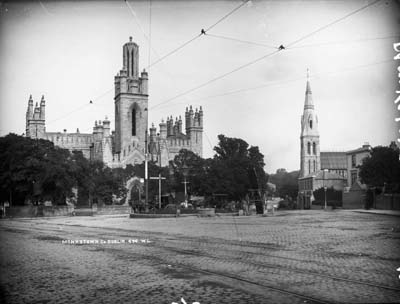
In the predominantly Protestant suburb of Monkstown, the churches of the two main religious denominations stand side by side
(NLI, LROY 696)
There were boarding houses, like Barclay's on Church Rd. and hotels, like Bushe's at Kingstown, which were clearly run along sectarian lines, but the great majority were mixed creed (see Clarke's of Harcourt St.). And all across the city were marriages between people of different faiths (see O’Neill household at Highfield House), people bringing up children in different faiths (see Grover household at Hollybank Rd. Clontarf and Farquharson household at Jones's Rd., Mountjoy) and people employing servants of various faiths (see Freeman household at Ailesbury Rd., Ballsbridge).
The diversity of many streets was as striking as the instances of streets where one creed or the other dominated. An example is Oaklands Park in Pembroke on the southside which was home to Catholics, Protestants, Presbyterians, Methodists, Wesleyans, Baptists, independent Christians and various individuals who refused to disclose their religion. Closer to the city centre, Harcourt Street was also a place of religious diversity.
At the head of the Catholic Church in the city was the Archbishop of Dublin, William Walsh, a strong nationalist whose politics were more Sinn Féin than Irish Nationalist Party and who was the first chancellor of the National University of Ireland. There were large congregations of religious in the city. The Dublin diocesan seminary was based at Clonliffe Road, the Vincentians were based at All Hallows at Gracepark Rd., Drumcondra), the Jesuits at Milltown and the Holy Ghost Fathers at Kimmage. Priests, like O’Callaghan at Eccles St. were also heavily involved in education in the city, as were Christian Brothers, who had schools and monasteries, like this one at Gracepark Rd.
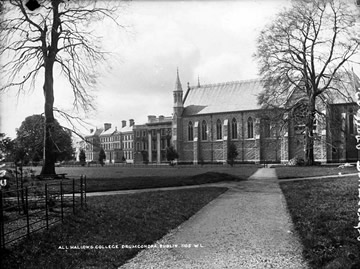
An exterior shot of All-Hallows College, Drumcondra (c. 1900) which was run by the Vincentians.
(NLI, LROY 1105)
Orders of nuns ran national schools, exclusive boarding-schools, homes for the aged and the destitute, and established hospitals and workhouses. The Sisters of Charity ran St. Vincent’s hospital and Magdalene asylums and the Carmelites were also in Dublin. Piety, of course, was as much about people as it was about the religious orders and the nineteenth century devotional revolution continued to impact on the city in 1911. Dubliner Frank Duff was later inspired by Marian piety to establish the Legion of Mary, while there was also a local devotion to the reformed alcoholic labourer, Matt Talbot,who lived with his mother at Rutland St.
The Church of Ireland formed the largest minority in the city and had a formidable network of churches, schools and hospitals across the city. In the decades before 1911, Protestant domination of the higher professions (see return for Dodgson Hamilton Madden, High Court judge, Donnybrook) was steadily eroded by the emergence of an educated Catholic elite. Nonetheless, in law, medicine, the civil service and in the upper ranks of the army, Protestants were substantially over-represented. There is clear evidence that certain trades were associated with certain religions. Coopering was dominated by Catholic workers, while city’s growing electrical industry was staffed by Protestants, many of whom had arrived from England (see Dalton of Dargle Rd., Drumcondra).
For so long the dominant power in the city, there was a growing feeling of isolation among the capital’s Protestant and unionist elite (see return for de Montmorency of Kerrymount, Ballybrack). Nationalists had taken charge of Dublin Corporation and, although their militancy was largely rhetorical, the sense of rising nationalist fervour was undeniable (see return for John Farrell, Dawson St., Lord Mayor of Dublin). There were constant Catholic concerns at what was perceived as proselytising by Protestants. Attempts by Protestants to improve social welfare provision in the city, such as the Church of Ireland social services union fund for elderly women, were often criticised as being driven by ulterior motives.
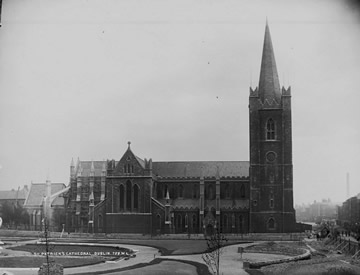
As a result of the disestablishment of the church in 1872, St. Patrick's became a national cathedral for the Church of Ireland. This is a view c. 1900.
(NLI, LROY 759)
It was such fears which drove the Catholic hierarchy to reject any notion of non-denominational education in the city, whether at national, secondary or university level. Prestigious fee-paying schools such as Blackrock College for Catholics, Monkstown Park and Alexandra College for Protestants, and Wesley College for Methodists, emphasised the divide. Ultimately, though, students from these schools were destined for similar careers in the professions, or in the public service across the British empire.
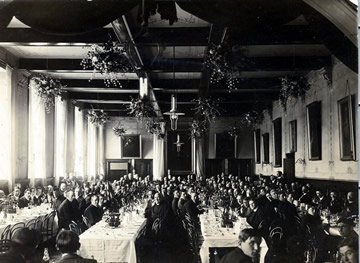
Blackrock College, a prestigious fee-paying school for Catholics in South Dublin, celebrated its golden jubilee with a banquet in 1911.
(Blackrock College Archive)
In 1911 there were several thousand Jews in Dublin, mostly based around Portobello and the South Circular Road. Many were immigrants from Eastern Europe, including Poland (Solomon of Pleasant St.) and Russia, where they had fled the pogroms of Tsar Alexander II (Cohen of Pleasant St.). Many more were Jewish immigrants who moved over from Britain and established themselves as dentists (Goldberg of Harcourt St.) and surgeons (Leventon of Harcourt St). They built synagogues and schools, while other Jewish institutions established in the area included a Hebroth at 52 Camden Street, one of six in the Portobello area, formed for religious and charitable purposes as a transitional place for Jewish immigrants adapting to life in Dublin.
Quakers - the Society of Friends - had been present in Dublin from the 1650s. From modest beginnings, they had evolved into an often wealthy community of industrialists and entrepreneurs. Among their most prominent families in Dublin were the Jacobs, who owned a substantial confectionery business, and the Bewleys of Kerrymount, biscuit makers and tea and coffee merchants who owned thriving Oriental-style cafes in the city.
